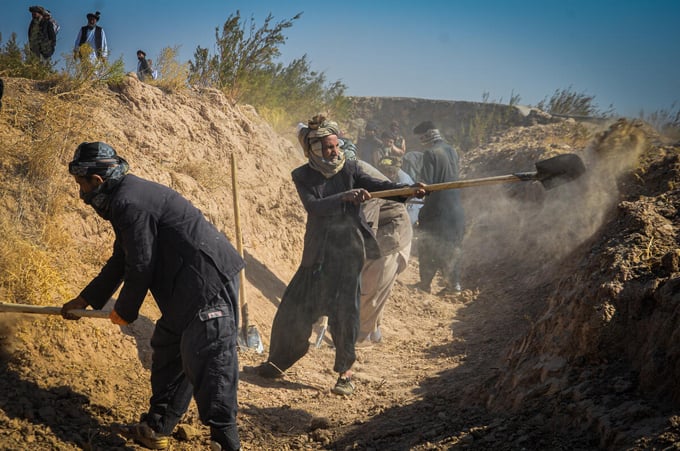November 27, 2025 | 08:33 GMT +7
November 27, 2025 | 08:33 GMT +7
Hotline: 0913.378.918
November 27, 2025 | 08:33 GMT +7
Hotline: 0913.378.918

Construction workers dig trenches before gabions are built on the HariRud-Murghab river basin as part of community irrigation and livelihood enhancement - funded by Japan Government in Herat, Afghanistan.
The Food and Agriculture Organization of the United Nations (FAO) has received $11.9 million in contributions from the Government of Japan to scale up its emergency and resilience activities in humanitarian contexts across Africa, Asia, Europe, and the Middle East. This funding will support 14 critical projects aimed at tackling urgent humanitarian needs.
The funds will be allocated to address the following key priorities: supporting small-scale farmers affected by climatic and economic shocks in Afghanistan; enhancing food security and nutrition in Chad, particularly in regions impacted by the Sudan crisis; providing assistance to displaced households in Mozambique; improving flood management initiatives in Uganda; building agricultural roads and irrigation canals in Mali; managing abandoned, lost, or discarded fishing gear in the West Indian Ocean; catalyzing agricultural investments in Cote d’Ivoire, and others.
“We thank the Government of Japan for this timely contribution. This funding is part of Japan's ongoing commitment to address time-critical needs while fostering sustainable and resilient livelihoods in crisis-affected communities”, said Rein Paulsen, Director of the FAO Office of Emergencies and Resilience.
“Emergency agricultural assistance provides a lifeline to those most severely affected by conflict, climate crisis and economic downturn. This type of support not only saves lives but also empowers communities with the tools to secure their own futures by breaking the cycle of dependency, revitalizing local markets and promoting lasting recovery,” he added.
Long-standing cooperation
Since joining FAO in 1951, Japan has been a key partner and driving force in the global fight against food insecurity. Through its long-standing collaboration with FAO, Japan has significantly contributed to improving food security and nutrition for vulnerable populations, including internally displaced persons, refugees, and communities affected by conflict and natural disasters.
In 2024, Japan reaffirmed its commitment with a substantial contribution of $11.2 million to support FAO’s emergency and resilience activities across Africa, Asia, Europe, and the Middle East. Among others, these include a $3 million project for developing inland fisheries in rural communities in Sri Lanka; responding to floods in East Africa; supporting livelihoods in the conflicted-affected areas of Ukraine; strengthening rural livelihoods in the Cabo Delgado province of Mozambique; increasing the resilience of agriculture and livestock-based livelihoods in Afghanistan; building resilience of flood-affected communities in Mauritania; and improving food security and nutrition outcomes through emergency and early recovery assistance in Northern Ethiopia. In conflict and climate-affected regions like Tigray, where local farmers produced five times more food than external aid in 2021, self-reliance proves its efficiency.
(FAO)

(VAN) A new study reveals how the simultaneous effects of ocean acidification, salinity and loss of oxygen are making the world more fragile.

(VAN) Hopes are growing that the creation of the first 3D turkey gut model could be a turning point in the battle against the virulent blackhead disease.

(VAN) Tyson, America’s biggest meat supplier, plans to shutter one of its largest beef processing plants as the industry continues to struggle with low cattle supplies and political pressure from Washington.

(VAN) New FAO study shows how digital solutions are empowering farmers and fishers to prevent losses and build resilient agrifood systems.

(VAN) Brazil's COP30 presidency pushed through a compromise climate deal on Saturday that would boost finance for poor nations coping with global warming but that omitted any mention of the fossil fuels driving it.

(VAN) Poultry farmers in the UK have been warned that they could face one of the worst winters yet for bird flu.

(VAN) Prices of main-crop paddy have risen sharply, with jasmine rice hitting 16,100 baht per tonne — the highest level in years.